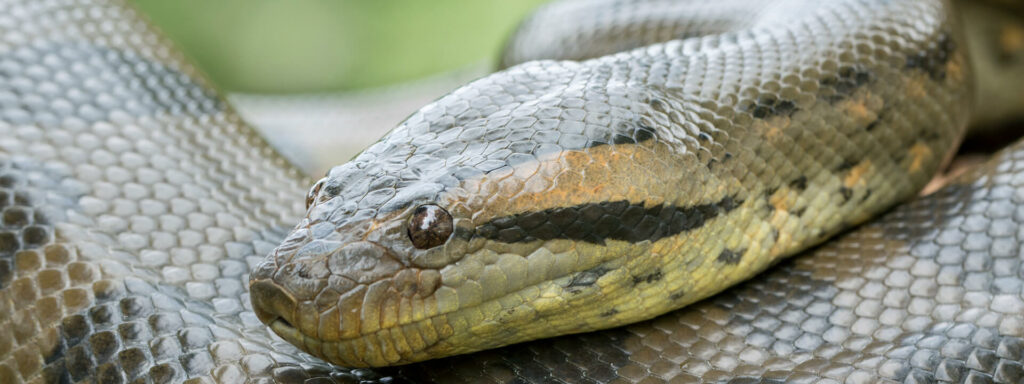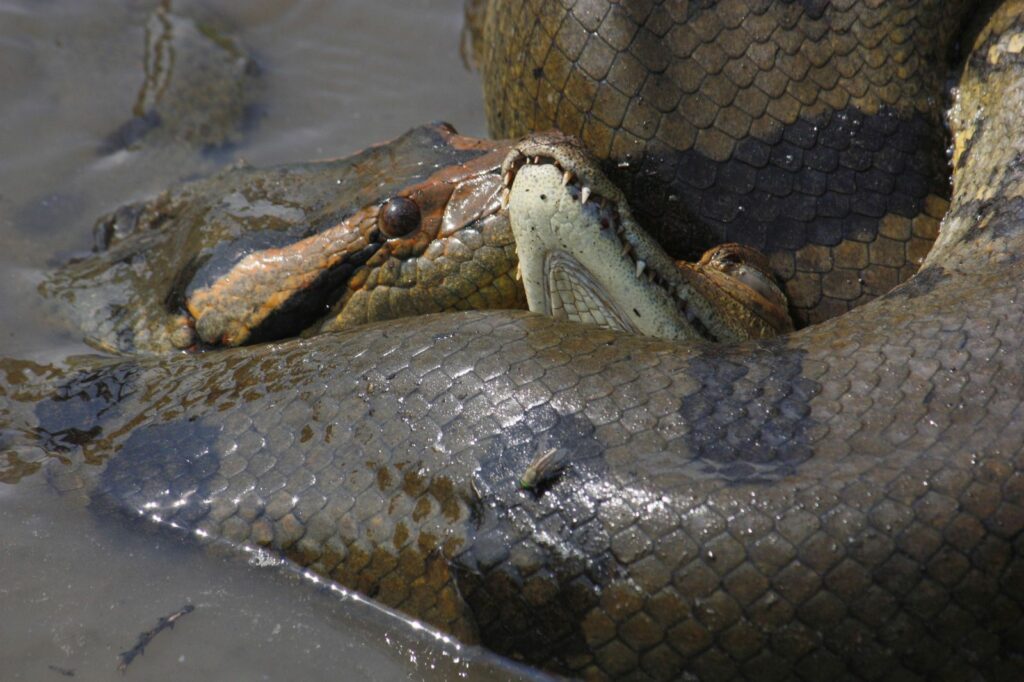How big do anaconda get?

Anacondas are among the most iconic and fascinating creatures in the animal kingdom. These large, non-venomous snakes are primarily found in tropical South America, inhabiting swamps, marshes, and slow-moving streams. They belong to the family Boidae and are closely related to boas, which are known for their impressive size and strength.
Anacondas are big, powerful and stealthy
Anacondas possess a range of specialized anatomical features that contribute to their impressive size, predatory capabilities, and survival in their natural habitats. Like all snakes, are covered in scales that provide protection, aid in movement, and regulate moisture levels. Their scales are keeled, meaning they have a ridge down the center, which assists in gripping surfaces and enhances their traction while navigating various terrains, including wetlands and dense vegetation.
The skin of anacondas is highly flexible and stretches to accommodate large prey items during feeding. This elasticity is crucial for their survival, as it allows them to consume meals that can be several times larger than their own head diameter. Additionally, their skin plays a role in thermoregulation, helping anacondas maintain optimal body temperatures by absorbing and retaining heat from their environment.
Land and Water Reptiles
Anacondas have a robust skeletal structure adapted for both land and water. Their vertebral column consists of numerous vertebrae with highly flexible joints, allowing for efficient movement and the ability to coil and constrict prey. The ribs of anacondas are long and can expand during feeding to accommodate the ingestion of large prey items.
One of the notable skeletal adaptations of anacondas is their ability to unhinge their lower jaw, a feature common among snakes. This unique adaptation allows them to open their mouths to extreme widths, facilitating the swallowing of prey items that would otherwise be impossible to consume.

Master of Constriction
The muscular system of anacondas is exceptionally powerful and well-developed, particularly in the midsection of their bodies. These snakes rely on constriction as their primary method of subduing prey. When hunting, anacondas strike at their target, wrapping their coils around the victim and squeezing with immense force.
Constriction serves two essential purposes for anacondas. First, it restricts the prey’s ability to breathe, leading to suffocation. Second, it prevents the prey from expanding its chest cavity, further impeding respiration. Anacondas adjust the intensity of constriction based on the size and resistance of their prey, demonstrating a high level of control and precision in their hunting strategy.
Size Matters – How Big Do Anacondas Get?
Anacondas are renowned for their impressive size, making them a subject of curiosity and awe among wildlife enthusiasts and researchers. Among the various species of anacondas, the Green Anaconda (Eunectes murinus) stands out as the largest and heaviest snake in the world, showcasing the remarkable diversity and adaptability of these reptiles.
Green Anaconda (Eunectes murinus)
The Green Anaconda is undoubtedly the giant among anaconda species. Adult Green Anacondas can attain astounding lengths of up to 20 feet (6 meters) or more, with verified records of individuals reaching lengths exceeding 25 feet (7.6 meters). These massive snakes can weigh over 200 pounds (90 kilograms), with the heaviest recorded specimen tipping the scales at approximately 550 pounds (250 kilograms). However, such colossal sizes are exceptional and rare in the wild.
Green Anacondas exhibit sexual dimorphism, with females generally growing larger than males. Female Green Anacondas can reach lengths of around 15 feet (4.5 meters) on average, while males typically measure between 10 to 12 feet (3 to 3.7 meters). This size difference is believed to be advantageous during mating and reproductive processes.
Yellow Anaconda (Eunectes notaeus)
While not as massive as their Green counterparts, Yellow Anacondas are still formidable predators in their own right. These snakes are smaller in size, with adult Yellow Anacondas averaging lengths of 6 to 12 feet (1.8 to 3.7 meters). Females tend to be larger than males, similar to Green Anacondas.
Despite their smaller stature, Yellow Anacondas possess impressive strength and constricting abilities, allowing them to tackle prey items such as fish, birds, and small mammals. Their yellowish coloration and blotched patterns help camouflage them within their marshy habitats.
Dark-Spotted Anaconda (Eunectes deschauenseei)
The Dark-Spotted Anaconda, also known as the De Schauensee’s Anaconda, is another species within the Eunectes genus. These anacondas are considerably smaller compared to their Green and Yellow counterparts, with adult lengths ranging from 6 to 9 feet (1.8 to 2.7 meters) on average.
Dark-Spotted Anacondas derive their name from the distinctive dark spots or blotches that adorn their bodies. These markings serve as effective camouflage among the dense vegetation of their wetland habitats, aiding them in ambushing prey and evading potential threats.
Size Variations and Environmental Factors
It’s important to note that the size of anacondas can be influenced by various environmental factors, including habitat quality, availability of prey, and genetic predispositions. Individuals residing in rich and abundant environments with ample food resources may exhibit larger sizes compared to those in more challenging or resource-limited habitats.
Additionally, anacondas undergo periods of growth and development throughout their lives, with juveniles starting off small and gradually increasing in size as they mature. Factors such as nutrition, climate, and predation pressures can impact the growth rates of these snakes, contributing to size variations within populations.
Do Anacondas Never Stop Growing?
The notion that anacondas never stop growing is a common misconception perpetuated by myths and exaggerated tales. While anacondas are indeed capable of reaching impressive sizes, there are biological and physiological factors that limit their growth over time.
Size and Growth Patterns
Anacondas, like many other reptiles, exhibit indeterminate growth, meaning they continue to grow throughout their lives, albeit at a decreasing rate as they age. This growth pattern is characteristic of many reptile species and is influenced by factors such as genetics, environmental conditions, and available resources.
As juveniles, anacondas experience rapid growth, with their bodies elongating and gaining mass quickly. However, this growth rate gradually slows down as they reach adulthood. While they may continue to gain size and weight, the rate of growth becomes more gradual, eventually tapering off in older individuals.
Size Limitations and Physical Constraints
Despite their potential for continuous growth, anacondas are bound by certain size limitations dictated by their biology and environment. Factors such as skeletal structure, organ development, and metabolic demands impose constraints on how large these snakes can become.
Anacondas have a sturdy but flexible skeletal system that allows them to swallow large prey items, thanks to their ability to unhinge their jaws. However, there are limits to how much their bodies can stretch and accommodate prey, particularly as they grow older and their musculature and connective tissues may become less flexible.
Additionally, the metabolic demands of sustaining a massive body size may become increasingly challenging as anacondas age. Efficient energy utilization, prey acquisition, and digestion play crucial roles in supporting their growth, and as these processes may become less efficient with age, they can contribute to a slowdown in growth rates.
Environmental Influences on Growth
The growth potential of anacondas is also influenced by environmental factors such as temperature, food availability, and habitat quality. Anacondas in favorable environments with abundant prey resources and optimal temperatures may experience more robust growth compared to those in less favorable conditions.
Additionally, environmental stressors, pollution, habitat degradation, and human disturbances can impact the growth and overall health of anaconda populations.










